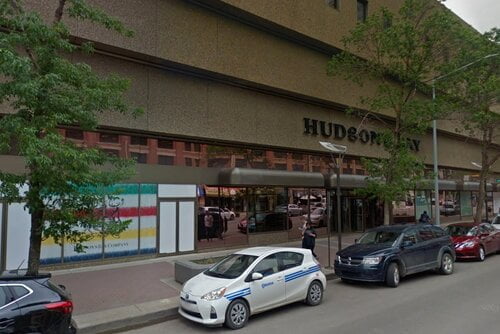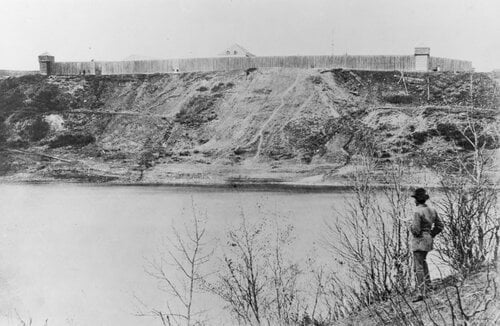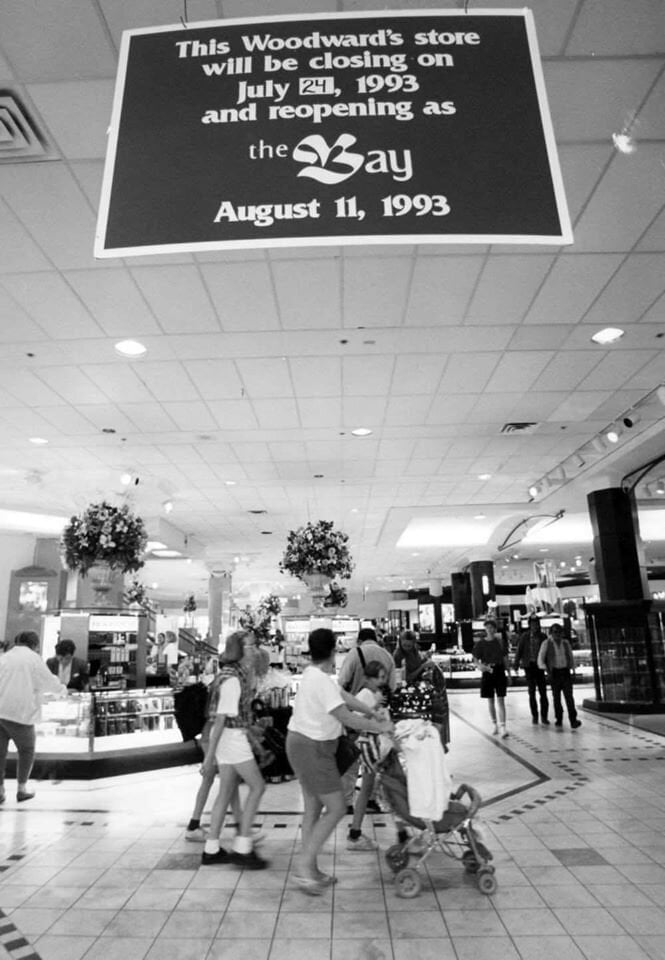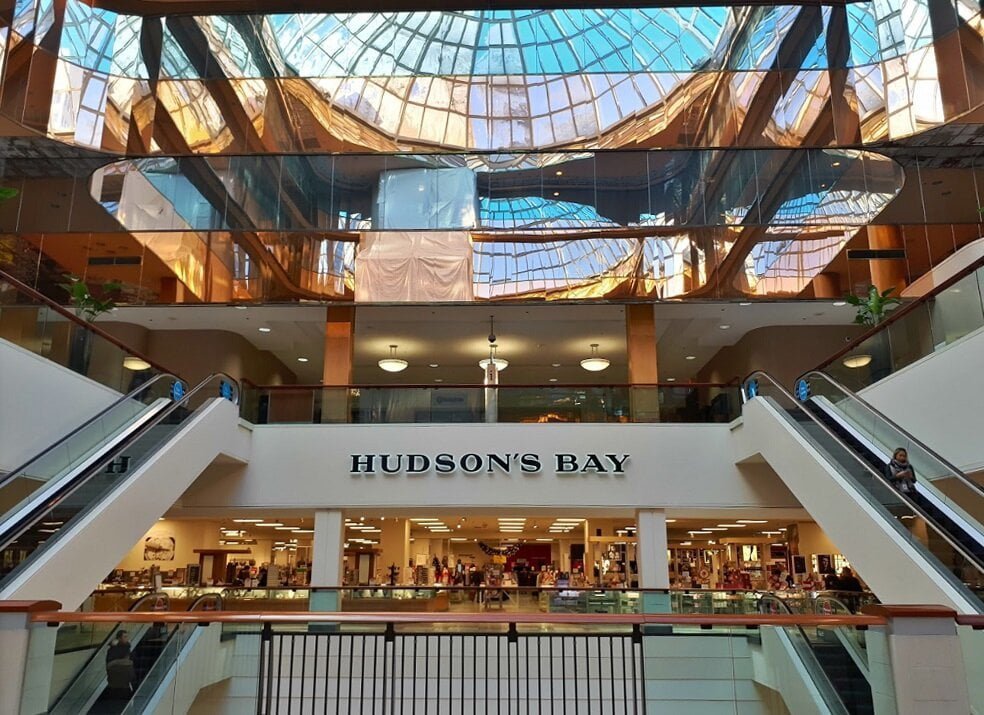The Hudson’s Bay Company has announced that it is shutting its 168,000 square foot Hudson’s Bay store in downtown Edmonton this fall, marking the closure of the last remaining department store in the city’s core. It’s a blow to Edmonton’s downtown which in January saw large-format luxury retailer Holt Renfrew shutter and years before that, the closure of Eaton’s and Woodward’s department stores nearby.
The downtown Edmonton Hudson’s Bay store will reopen temporarily on May 19 along with the company’s other Alberta stores. The downtown Edmonton store will gradually close by the fall and employees will be provided with the opportunity to transfer to Hudson’s Bay’s other five remaining Edmonton-area stores which include Southgate Centre, West Edmonton Mall, Kingsway Mall, Londonderry and St. Albert Centre.
Located in the Edmonton City Centre shopping complex, the downtown Hudson’s Bay store moved into its current location in May of 2002. Before that, an Eaton’s department store occupied the space — Eaton’s went bankrupt in 1999 before being acquired by Sears Canada. Hudson’s Bay relocated to its current downtown space after exiting a large building nearby that had been formerly occupied by a Woodward’s store. Before relocating into the Woodward’s space, Hudson’s Bay occupied a massive five-level building 470,000 square foot building on Jasper Avenue that in the 1990s was branded as the ‘Hudson’s Bay Centre’. The Hudson’s Bay Centre shopping complex was a failure and the building was eventually sold and converted to the current University of Alberta Enterprise Square. Remarkably, Hudson’s Bay operated two downtown Edmonton stores for about two years in 1993-1995, including the Jasper Avenue Hudson’s Bay Centre store as well as the store in the former Woodward’s space.


CURRENT STORE. PHOTO: GOOGLE STREETVIEW 
CURRENT STORE. PHOTO: GOOGLE STREETVIEW
Last year, Oxford Properties sold the two-block long Edmonton City Centre complex, which includes a shopping centre, office towers and a hotel, to a four-member group of investors. At the time we were told that the group had been considering demolishing the downtown Edmonton Bay store for a new tower to capitalize on the site’s value through densification. Hudson’s Bay had denied that the downtown Edmonton store was closing though in years past, Oxford Properties was said to have been looking to other uses that could have included a Nordstrom store in the Bay space — plans were also in place to add new Holt Renfrew and Target stores to Edmonton City Centre, though plans changed with the downturn in oil prices in 2015 which saw Alberta’s economy collapse.
Edmonton will become the first major city in Canada (with a population of nearly one million within city boundaries) to have no downtown department stores. This puts Edmonton in line with many cities in the United States which over the years have seen the shuttering of all downtown department stores. Winnipeg is likely the next large city to lose its downtown Hudson’s Bay store — the Winnipeg store once spanned 675,000 square feet and was the company’s flagship store for many years until a new Toronto store at 44 Bloor Street West opened in 1974. Downtown department stores also still operate in Vancouver, Toronto, Ottawa, Montreal and Calgary.
Calgary, which has an unofficial rivalry with Edmonton, currently has three department store retailers in the city’s core. Hudson’s Bay operates a 500,000 square foot flagship store and nearby, La Maison Simons operates a 96,000 square foot store. A block away, Holt Renfrew operates a 150,000 square store in a space once occupied by Eaton’s.
In the two largest cities in Saskatchewan, Hudson’s Bay operates downtown stores in Saskatoon and Regina. Both stores relocated to downtown shopping centres from standalone buildings after the demise of Eaton’s.


In downtown Edmonton, the 32,000 square foot Holt Renfrew store closed in January of this year. Half a decade prior, plans had been drawn up to move Holts into a much larger location at Edmonton City Centre in part of the space that was once occupied by a Woodward’s department store. Woodward’s had a 400,000 square foot store which opened in that location in downtown Edmonton in 1974 until its bankruptcy in 1993 — Woodward’s first downtown Edmonton store opened on the same block in 1926. Iconic Toronto-based Eaton’s operated a large multi-level store nearby until its demolition in the mid-1980s to make way for the new Edmonton Eaton Centre, which merged with the adjacent Edmonton Centre to create the single Edmonton City Centre complex in 2002.
The Hudson’s Bay Company founded its Fort Edmonton trading post, focused on the fur trade, in 1795 near the current city of Fort Saskatchewan. Fort Edmonton was relocated to downtown Edmonton in 1802 in the city’s Rossdale area and in 1830, it relocated up the hill near where the Alberta Legislature is currently located. Hudson’s Bay’s first standalone downtown Edmonton store opened on Jasper Avenue in 1890 in a town of only 400 people. In 1905 when Alberta was founded and Edmonton became the capital, Hudson’s Bay expanded its store to three levels after the community grew to a population of 7,000.
Further expansions saw the block grow and by 1956, it encompassed 470,000 square feet on the north side of Jasper Avenue between 102 Street and 103 Street. In 1989, the Hudson’s Bay Company sold the massive Edmonton store to Stewart Green Properties and the Hudson’s Bay Centre was developed with the Bay occupying 118,000 square feet and the remainder tenanted by smaller retailers and food & beverage concepts, which never reached its potential.







The suburbanization of retail has hit the downtown cores of cities across North America hard. The rise of automobiles and the suburban shopping centre saw consumers gravitate away from downtowns, creating competition and reduced foot traffic which proved insurmountable for many downtown businesses. Department stores themselves have become irrelevant over the years in North America. The rise of brands themselves along with retail category killers, discounters and online shopping have all played a role.
The Hudson’s Bay Company was recently taken private by CEO Richard Baker, and it’s unclear what the future holds. Some are speculating that a filing could be at play to rightsize the chain which currently has 89 stores across the country, not to mention other banners including Saks Fifth Avenue.
Sources have said that a concession strategy is in the works for Hudson's Bay which will see departments run by third party vendors for the Bay stores that remain open after a post-privatization restructuring.




![[Webinar] Black Friday 2024: Strategies for Ecommerce and Brick-and-Mortar Retailers](https://retailinsider.b-cdn.net/wp-content/uploads/2024/11/unnamed-5-324x160.png)


It’s too bad that they couldn’t make it work, but I’m not too surprised. This location was oddly arranged and in close competition with a newly renovated Hudson’s Bay store at Kingsway Mall only a few blocks north of downtown. As a side note, Sears management considered but passed on this former Eaton’s location for its aubergine-heavy "eatons" experiment, as shopping traffic in the mall (and downtown) was already questionably low in 1999.